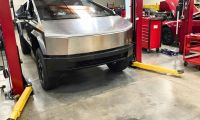Coalition of Automotive Lightweighting Materials (CALM) is the first known organization of its kind to coalesce the strengths and knowledge of the aluminum and plastics/composites industries with technology providers in design, fabrication and joining to accelerate the implementation of mixed-material solutions that will reduce vehicle mass.
The rationale is simple. Reduce vehicle mass, because it is uniformly recognized as one of the key enabling technologies necessary to help achieve the new fuel economy targets, as well as reducing related tailpipe emissions. Fact is, vehicle fuel economy still remains one of the nation’s critical policy concerns. Furthermore, the recent Notice of Proposed Rulemaking from the National Highway Traffic Safety Administration (NHTSA) and the Environmental Protection Agency (EPA) to establish vehicle corporate average fuel economy standards at 54.5 mpg in 2025 is in response to these concerns.
Historically, automakers have steadily increased the amount of aluminum, plastics/composites and high strength steel in cars to lessen vehicle mass, but the new fuel economy targets will require further acceleration in the rate of implementation.
“The aluminum and plastics/composites industries are developing advanced materials to help auto makers design lighter and safer cars. Leading technology companies are also developing weight-saving solutions that include these materials along with steel for new applications. By working together we can accelerate the application of these progressive materials and solutions,” said Dr. Jay Baron, CAR’s President, and the Director of CALM.
Based on the news release from CAR, CALM’s purpose is to support the cost-effective integration of mixed materials to achieve significant reductions in weight through the collaborative efforts of technology providers with the auto manufacturers. CALM is supported by The Aluminum Association’s Aluminum Transportation Group and the American Chemistry Council, which combined, represents a membership of more than 200 companies. A representative from each association will serve on CALM’s steering committee with Baron.
“As automakers rapidly transition to low weight, high strength materials, multi-materials solutions will be vital to boosting fuel economy and cutting emissions. Through individual company efforts and through the new CALM partnership, the aluminum industry is committed to working with our customers and other suppliers to further accelerate and ease the adoption of advanced materials options,” said Randall Scheps, chairman of the Aluminum Association’s Aluminum Transportation Group (ATG) and Marketing Director, Alcoa Inc.
Integrating advanced low-weight materials can present challenges with the design, joining, and structural validation. By working collaboratively with automakers, CALM aims to overcome these challenges through pre-competitive efforts that will accelerate the adoption of down-weighting technologies and the overall benefits they offer automakers and ultimately consumers.
“Lightweight materials are one of the key technologies needed to produce more fuel efficient cars for the 21st century. Partnerships like CALM will help automotive companies utilize plastics, composites and other lightweight materials to meet these goals.” said Steve Russell Vice President of Plastics at the American Chemistry Council.
“One of the first tasks for CALM will be to meet with the engineering groups at the automakers to understand their mass reduction strategies and challenges so the supplier industries can develop and apply their technology solutions with each auto company,” said Baron. In addition to the material associations, individual materials and technology organizations have joined CAR in support of CALM including 3M, Altair, BASF, EWI, Material Sciences Corporation, Plastic Omnium, PPG, Shiloh Industries and Trexel. Additional organizations are expected to add their support in the weeks ahead.
Flashback to NAIAS 2012
It was just a few weeks ago that this reporter noted the light-weight body displays and use of aluminum by Mercedes-Bens for its new SL model. Read: Mercedes SL at NAIAS 2012 implies new leadership in lightweight body structures.
About the Center for Automotive Research (CAR)
CAR’s mission is to conduct research on significant issues related to the future direction of the global automotive industry, as well as organize and conduct forums of value to the automotive community. CAR performs numerous studies for federal, state and local governments, corporations and foundations.












Comments
A comment on Facebook
Permalink
A comment on Facebook questioned why we're wasting time on aluminum when carbon fiber would be lighter and stronger.
My answer: The process for carbon fiber is good for low volume but not high volume as in 60 units per hour. Significant mfg process changes will have to occur first and likely include banking of parts. Not impossible, but a definite Mfg paradigm shift for OEMs.
As another point of reference, here's an excerpt from the many remarks by DOE Secretary, Chu at the Detroit Economic Club: "For conventional internal combustion engine vehicles, a 10 percent reduction in vehicle weight can result in a six to eight percent improvement in fuel economy. That is why we are supporting research and development of high-tensile strength steels, aluminum and magnesium alloys, and carbon fiber composites. Our goal is to reduce body and chassis weight by 50 percent."